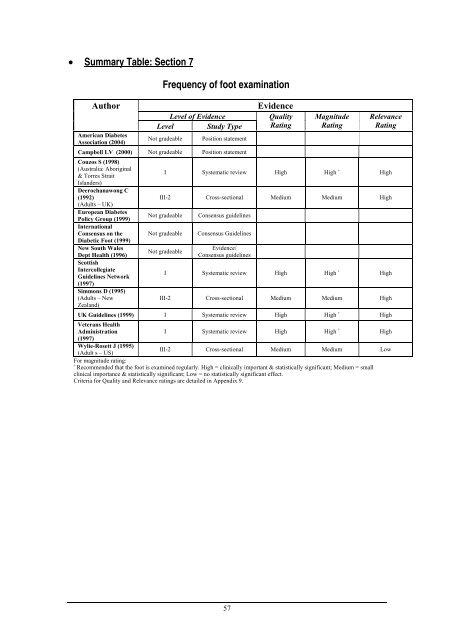Part 6: Detection and Prevention of Foot Problems in Type 2 Diabetes
Part 6: Detection and Prevention of Foot Problems in Type 2 Diabetes Part 6: Detection and Prevention of Foot Problems in Type 2 Diabetes
Summary - Frequency of Foot Examination• A number of studies have shown that routine foot examination is frequently notperformed in people with diabetes• No studies have examined the impact of frequency of foot examination on clinicaloutcomes in people with diabetes• There is general agreement that people with diabetes should have their feetexamined every year for risk factors and if risk factors are identified feet shouldbe examined more frequently56
• Summary Table: Section 7AuthorFrequency of foot examinationLevel of EvidenceLevel Study TypeEvidenceQualityRatingMagnitudeRatingRelevanceRatingAmerican DiabetesAssociation (2004)Not gradeable Position statementCampbell LV (2000) Not gradeable Position statementCouzos S (1998)(Australia: Aboriginal& Torres StraitI Systematic review High High + HighIslanders)Deerochanawong C(1992)III-2 Cross-sectional Medium Medium High(Adults – UK)European DiabetesPolicy Group (1999)Not gradeable Consensus guidelinesInternationalConsensus on the Not gradeable Consensus GuidelinesDiabetic Foot (1999)New South WalesEvidence/Not gradeableDept Health (1996)Consensus guidelinesScottishIntercollegiateGuidelines NetworkI Systematic review High High + High(1997)Simmons D (1995)(Adults – NewIII-2 Cross-sectional Medium Medium HighZealand)UK Guidelines (1999) I Systematic review High High + HighVeterans HealthAdministrationI Systematic review High High + High(1997)Wylie-Rosett J (1995)(Adult s – US)III-2 Cross-sectional Medium Medium LowFor magnitude rating:+Recommended that the foot is examined regularly. High = clinically important & statistically significant; Medium = smallclinical importance & statistically significant; Low = no statistically significant effect.Criteria for Quality and Relevance ratings are detailed in Appendix 9.57
- Page 7 and 8: 2.2 Issues for Foot Problems in Typ
- Page 9: • Aim to achieve the best possibl
- Page 12 and 13: Background - Peripheral Neuropathy
- Page 14 and 15: proportion of subjects with a durat
- Page 16 and 17: and an OR 1.1-7.8. This study also
- Page 18 and 19: Summary - Peripheral Neuropathy as
- Page 20 and 21: Section 2: Diabetes Foot ProblemsIs
- Page 22 and 23: predicting risk of amputation, 2.9
- Page 24 and 25: Summary - Peripheral Vascular Disea
- Page 26 and 27: Section 3: Diabetes Foot ProblemsIs
- Page 28 and 29: Evidence - Foot Deformity and Previ
- Page 30 and 31: people with both LJM and neuropathy
- Page 32 and 33: Summary - Foot Deformity and Previo
- Page 34 and 35: Section 4: Diabetes Foot ProblemsIs
- Page 36 and 37: Also in the Seattle study, 67 peopl
- Page 38 and 39: Summary - Ulcer as a Risk Factor fo
- Page 40 and 41: Section 5: Diabetes Foot ProblemsIs
- Page 42 and 43: The other frequently reported metho
- Page 44 and 45: side; and 82% having the same resul
- Page 46 and 47: Evidence Table: Section 5Detection
- Page 48 and 49: Background - Clinical Detection of
- Page 50 and 51: pulse was bilaterally absent in 1.8
- Page 52 and 53: Evidence Table: Section 6AuthorClin
- Page 54 and 55: Background - Frequency of Foot Exam
- Page 58 and 59: Section 8: Diabetes Foot ProblemsIs
- Page 60 and 61: Behaviour assessment scores, measur
- Page 62 and 63: Mazzuca et al (1986) studies 532 pe
- Page 64 and 65: with before the programme, after 1-
- Page 66 and 67: Evidence Table: Section 8AuthorEffe
- Page 68 and 69: Background - Glycaemic Control and
- Page 70 and 71: In a previous Japanese randomised s
- Page 72 and 73: Evidence Table: Section 9AuthorGlyc
- Page 74 and 75: Background - Footwear to Reduce Ulc
- Page 76 and 77: period. In addition people without
- Page 78 and 79: Comparisons of in-shoe foot pressur
- Page 80 and 81: The rate of plantar callus formatio
- Page 82 and 83: Evidence Table: Section 10AuthorFoo
- Page 84 and 85: Background - Foot Clinics and Multi
- Page 86 and 87: A prospective non randomised contro
- Page 88 and 89: Summary - Foot Clinics and Multi-di
- Page 90 and 91: Section 12: Diabetes Foot ProblemsI
- Page 92 and 93: and/or osteomyelitis; III - fore-fo
- Page 94 and 95: Summary - Economic consequences•
- Page 96 and 97: Section 13: Diabetes Foot ProblemsI
- Page 98 and 99: Some ethnic groups are associated w
- Page 100 and 101: Evidence Table: Section 13AuthorSoc
- Page 102 and 103: Calle-Pascual AL, Duran A, Diaz A,
- Page 104 and 105: Jannink MJ, van Dijk H, de Vries J,
• Summary Table: Section 7AuthorFrequency <strong>of</strong> foot exam<strong>in</strong>ationLevel <strong>of</strong> EvidenceLevel Study <strong>Type</strong>EvidenceQualityRat<strong>in</strong>gMagnitudeRat<strong>in</strong>gRelevanceRat<strong>in</strong>gAmerican <strong>Diabetes</strong>Association (2004)Not gradeable Position statementCampbell LV (2000) Not gradeable Position statementCouzos S (1998)(Australia: Aborig<strong>in</strong>al& Torres StraitI Systematic review High High + HighIsl<strong>and</strong>ers)Deerochanawong C(1992)III-2 Cross-sectional Medium Medium High(Adults – UK)European <strong>Diabetes</strong>Policy Group (1999)Not gradeable Consensus guidel<strong>in</strong>esInternationalConsensus on the Not gradeable Consensus Guidel<strong>in</strong>esDiabetic <strong>Foot</strong> (1999)New South WalesEvidence/Not gradeableDept Health (1996)Consensus guidel<strong>in</strong>esScottishIntercollegiateGuidel<strong>in</strong>es NetworkI Systematic review High High + High(1997)Simmons D (1995)(Adults – NewIII-2 Cross-sectional Medium Medium HighZeal<strong>and</strong>)UK Guidel<strong>in</strong>es (1999) I Systematic review High High + HighVeterans HealthAdm<strong>in</strong>istrationI Systematic review High High + High(1997)Wylie-Rosett J (1995)(Adult s – US)III-2 Cross-sectional Medium Medium LowFor magnitude rat<strong>in</strong>g:+Recommended that the foot is exam<strong>in</strong>ed regularly. High = cl<strong>in</strong>ically important & statistically significant; Medium = smallcl<strong>in</strong>ical importance & statistically significant; Low = no statistically significant effect.Criteria for Quality <strong>and</strong> Relevance rat<strong>in</strong>gs are detailed <strong>in</strong> Appendix 9.57



